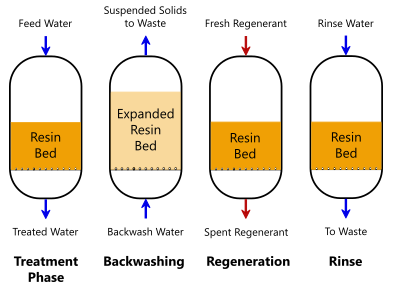Your Guide to PFAS Treatment Technologies and Perks
The occurrence of PFAS contamination in water resources requires a comprehensive understanding of offered treatment innovations. Various approaches, such as triggered carbon filtration, ion exchange systems, and progressed oxidation processes, present distinct benefits in addressing these relentless pollutants. Each modern technology not only targets details PFAS compounds yet likewise plays an essential duty in enhancing total water top quality and securing environmental stability. As areas come to grips with the effects of PFAS exposure, the choice of a suitable therapy approach becomes increasingly essential, prompting a more detailed evaluation of these modern technologies and their respective advantages.
Understanding PFAS Contamination
Comprehending PFAS contamination is critical for resolving its prevalent impact on environmental and human health and wellness (m270 pfas treatment). Per- and polyfluoroalkyl substances (PFAS) are a group of synthetic chemicals commonly utilized in different commercial and customer items due to their water- and grease-resistant homes. Typically found in firefighting foams, non-stick cookware, and water-repellent textiles, PFAS have actually entered the setting through manufacturing procedures, wastewater discharges, and seeping from land fills
As soon as released, these substances linger in the setting, resulting in extensive contamination of soil and water sources. Their one-of-a-kind chemical framework, identified by solid carbon-fluorine bonds, makes them resistant to degradation, causing a sensation called "permanently chemicals." PFAS can build up in the human body and the food chain, potentially causing damaging health and wellness effects, consisting of immune system interruption, developmental problems, and an enhanced threat of specific cancers.
Governing agencies and wellness organizations are increasingly acknowledging the significance of PFAS contamination, motivating efforts to check, examine, and alleviate its impacts. Recognizing the pathways of PFAS contamination is important for educating public law and creating efficient methods to safeguard both environmental and human health and wellness.
Overview of Treatment Technologies
Various treatment modern technologies have been created to address the difficulties presented by PFAS contamination in water and dirt. These technologies can be extensively identified into a number of groups, each with its distinct devices and effectiveness in eliminating PFAS substances.
One noticeable strategy is ion exchange, which makes use of material products to catch and eliminate PFAS from contaminated water. Another technology, advanced oxidation procedures (AOPs), uses solid oxidants and ultraviolet light to damage down PFAS into much less harmful substances.

Activated Carbon Filtering
Activated carbon filtering is a widely used approach for the elimination of PFAS from infected water, recognized for its capacity to adsorb a wide series of organic compounds. This innovation utilizes triggered carbon, an extremely porous material with a comprehensive surface, which assists in the binding of PFAS molecules with physical adsorption. The efficiency of activated carbon in removing PFAS is influenced by a number of elements, including the sort of carbon made use of, the call time, and the focus of PFAS in the water.
One of the benefits of turned on carbon filtering is its adaptability; it can be carried out in various arrangements, such as granular triggered carbon (GAC) systems or powdered activated carbon (POLITICAL ACTION COMMITTEE) systems. GAC systems are normally utilized in larger-scale applications, while PAC can be used in smaller sized or short-term setups. The technology is relatively simple to operate and keep, making it easily accessible for numerous water therapy facilities.

Ion Exchange Solution
Ion exchange systems represent one more effective strategy for the removal of PFAS from contaminated water, enhancing techniques like activated carbon filtering. These systems operate on the concept of exchanging ions in the water with ions hung on a resin material. Ion exchange materials can be particularly formulated to target Related Site the adversely billed PFAS compounds, efficiently recording them and enabling cleaner water to travel through.
Among the main benefits of ion exchange systems is their ability to get rid of a variety of PFAS, consisting of both long-chain and short-chain variants. This convenience makes them suitable for different applications, varying from community water therapy to industrial procedures. Additionally, ion exchange systems can usually achieve reduced discovery limitations for PFAS contrasted to a few other therapy methods, therefore boosting water quality.
However, it is important to keep track of and manage the regrowth of ion exchange media, as the performance can decrease with time due to saturation. Appropriate maintenance and substitute of the resin are vital for sustaining the system's effectiveness. Generally, ion exchange systems give a dependable and effective option for PFAS elimination, contributing substantially to safe drinking water standards and see this website environmental security.
Advanced Oxidation Processes
Advanced Oxidation Processes (AOPs) use effective oxidants to efficiently break down PFAS substances in polluted water. These ingenious treatment techniques produce extremely responsive varieties, such as hydroxyl radicals, that can damage down complicated PFAS particles right into much less unsafe byproducts. m270 pfas treatment. AOPs normally use mixes of ultraviolet (UV) light, ozone, hydrogen peroxide, or Fenton's reagent, enhancing the oxidation possibility and boosting degradation performance
The main benefit of AOPs lies in their capacity to target a broad series of PFAS substances, including both long-chain and short-chain variants. This versatility is necessary, as PFAS contamination often involves blends of different compounds with differing chemical frameworks. Furthermore, AOPs can be incorporated into existing water therapy systems, making them a practical solution for lots of communities and industries.
Nonetheless, the application of AOPs can be resource-intensive, requiring mindful factor to consider of operational expenses and power consumption. In addition, while AOPs work in breaking down PFAS, they might not totally eliminate all by-products, demanding additional therapy steps - m270 pfas treatment. In general, AOPs stand for an appealing opportunity for dealing with PFAS contamination, contributing to cleaner water resources and boosted public health and wellness protection

Final Thought
By choosing the appropriate innovation, areas can enhance water top quality, safeguard public wellness, and reduce the ecological dangers associated with PFAS exposure. Proceeded research and execution of these methods are essential for efficient monitoring of PFAS contamination in impacted locations.